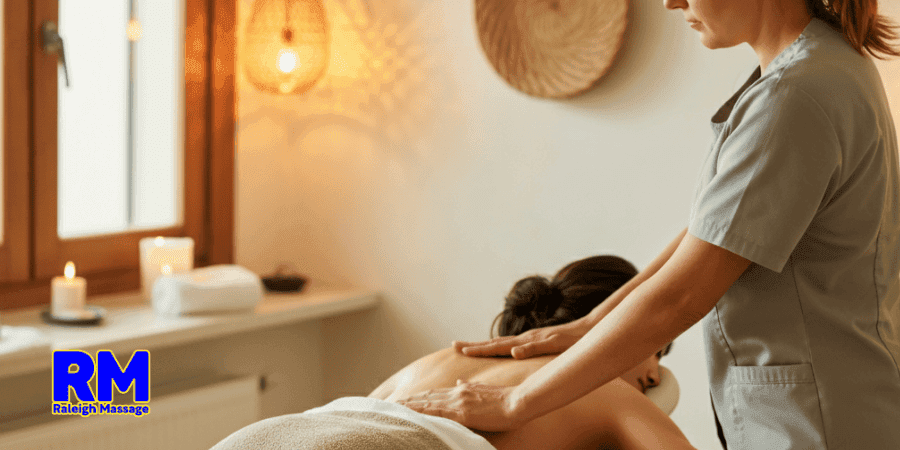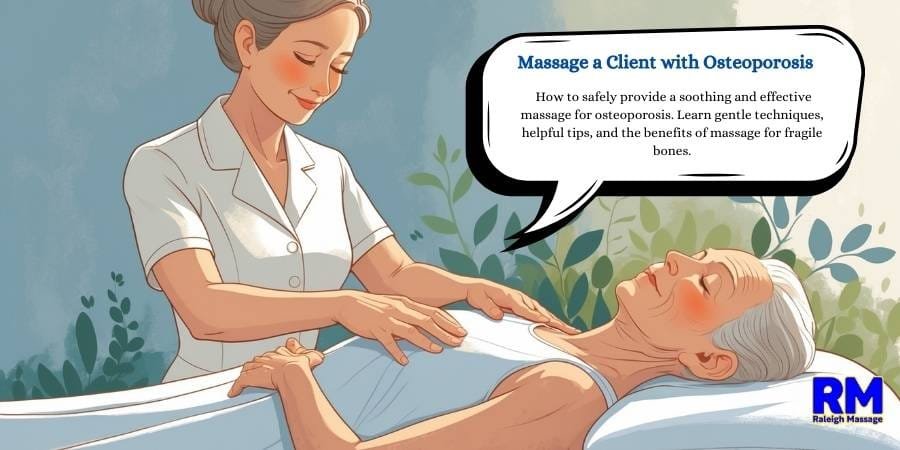Living with osteoporosis is not simple. The bones are weakened and even simple movement is hazardous. But a massage is not something you should shun. Actually, a massage with care is a method of pain alleviation, improved circulation, and even relaxation. But if you are a professional massage person working with a patient with a massage for osteoporosis, you have to exercise utmost care.
I’ve worked with clients with osteoporosis and I love how important a subtle touch is. I’m sure you are thinking, “How do I massage safely and effectively with a client with osteoporosis?” Let’s see.
What is Osteoporosis?
Before we talk about the massage process, we need to know what is osteoporosis. It is a medical condition in which bones get weakened and become brittle with a loss in density over time. It is quite frequent in old people and even in postmenopausal women, but anyone is a potential patient. The bones get extremely weakened and are made vulnerable to fracture with a loss in density. The patient is in pain, stiffness, and loss of mobility. Because of this, special care and tact are required while treating them.
The Basics of Massage for Osteoporosis
So, first, let’s discuss what we’re working with. Having osteoporosis is not simply having a fragile skeleton; it is a matter of sensitivity. With some, even the lightest pressure would hurt. I had clients who didn’t think they could even get a massage because they didn’t think their bones could handle it. The good news is, they might. The trick is to tailor techniques to fit their needs.
I always want to know how bad the condition is. Do they have a history of fractures? Does anyone have weaker areas? These are what guide me. If a client says their back and hips are very delicate, I’m not going to work on those areas. You listen and go slow with clients who are a bit fragile. On top of that, I also confirm that doctors have recommended them for massage. Safety is a top concern.
The Importance of a Gentle Touch
One of the most important things to remember when providing massage in the presence of osteoporosis is the importance of a gentle touch. Bones are more frail with osteoporosis, and pressure from a firm touch would be painful or even result in a fracture. Be mindful of how hard you’re pressing and keep it towards the lighter end of the spectrum. I like to begin with very light stroking and noticing how comfortable the client is.
In my practice, clients with osteoporosis are quite responsive to softer and more gentle treatments. One such treatment is effleurage with a light touch, a mild type of Swedish massage with sweeping and flowing strokes. These are aimed at inducing relaxation, stimulation of circulation, and dissipation of tensions in the muscles without compressive forces on the bones.
Techniques to Use in Massage for Osteoporosis
When I massage a client with osteoporosis, I highlight specific techniques not only because they are gentle but because they are also productive. The following are a few I have found particularly helpful:
- Effleurage (Light Stroking)
Effleurage is a soothing technique with the use of slow, even strokes on the body. It is a method of quieting down the client, getting the circulation going, and preparing the body for deep working—or deep working, where necessary. The touch is made fluid and light and is not pressed on vulnerable areas.
- Friction (Light)
Friction is a technique with subtle, rotating movement. It helps work on tensions in the muscles around joints but must be exercised with caution. In clients with osteoporosis, I would recommend a very subtle touch and working in short bursts. It is possible with subtle friction to relieve stiffness without risking damage to the bones.
- Kneading (Gentle)
Though kneading is widely used in classical massage in order to break down knots in muscles, I would advise using it with care with clients who have osteoporosis. If you choose to use kneading, direct it on the softer tissue sections, such as the muscles in the shoulders, neck, and top back. Avoid excessive pressure on joints and bones.
- Stretching (Gentle and Passive)
Gentle, passive stretching is a great addition to a massage treatment in the treatment of osteoporosis. Be extremely cautious, however. Don’t force a stretch and keep the client comfortable. Easy stretches are helpful in increasing flexibility and pain reduction in the muscles but are never forceful.
- Trigger Point Therapy (Light)
Trigger points, or knots in the muscles, are common in clients with osteoporosis. It is possible to relieve the tension with mild trigger point treatment. Hold pressure on the knots very gently and briefly. Be sure to monitor the client frequently to reassure them they are not in pain.
Areas to Avoid
While many areas of the body are okay with massage, there are a few where special care is necessary with clients who suffer from osteoporosis. These are areas where the bones are extremely fragile, such as the hips, spine, and ribs. The wrists and ankles are also areas where little care is in order because they are susceptible to fractures.
When I massage clients with osteoporosis, I’m sure not to massage deep pressure over the rib area and spine. I massage the softer tissues and muscles around them. I’m also sure not to massage heavily on the hips and knees because these are vulnerable points.
Establishing a Comfortable Environment
Comfort is key while performing a massage, particularly on clients with osteoporosis. Because they may already be in pain and have reduced mobility, the room is comfortable and tranquil. I ensure the room is properly heated in a way that releases the muscles because cold temperatures would only cause stiffness.
Make sure the table is at a comfortable level for the client and myself. I would prefer a little above with clients with osteoporosis because there is not quite such pressure on them to get on and get off the table. If necessary, I position the client in a comfortable position with pillows.
It’s also a practice I recommend informing the client while giving the massage and letting them know they are comfortable and not in pain. Communication is key. I ask them how they are doing and if I need to adjust what I’m doing. It makes the massage comfortable and secure.
Precautions to Keep in Mind
Massage for osteoporosis is really useful, but there are a number of precautions we need to bear in mind. These are a few points I keep in mind:
- Consult the Client’s Physician: It is a sound practice to see the client’s physician before treating a client with osteoporosis. Not only is it a way of ensuring the client is massage-compatible but also a method of determining specific contraindications and precautions.
- Avoid High-Pressure Points: Avoid over-pressing vulnerable points like hips, ribs, and spine. Ensure only subtle moves are made with a focus on relaxation and circulation.
- Monitor Bone Brittleness: The bones are rendered brittle with osteoporosis, and how hard you are pressing is something to monitor. The easiest way not to get injured is with sweeping, light strokes.
- Adjust Techniques Accordingly: Each client is distinct. Those with mild symptoms and the frail are among them. It is important to adjust your techniques based on how the client is experiencing. Don’t cross their boundary.>
- Encourage Relaxation: Because pain is amplified with anxiety, relaxation is a major intention of massage. By creating a calming and serene mood, healing is increased and pain is reduced.
Massage for osteoporosis is a nice way to keep the client in harmony with their illness and ease a little pain and stiffness. By utilizing subtle healing manipulations and paying close attention to pressure and position, you can provide a secure and helpful massage. Pay close attention and watch the client’s body carefully, ask how each manipulation is going, and adjust accordingly.
If you’re treating a client with osteoporosis, I would recommend a respectful and delicate touch. The touch itself is going to play a significant role in how they’ll accept what you’re doing. If clarification is necessary or would prefer to talk about experiences, don’t hold back.
If you’re in Wake Forest and the greater Raleigh area and need a massage therapist with specialized training in working with clients who have osteoporosis, see Raleigh Massage. I would enjoy having the privilege of working with you and members of your family with pain-relieving and calming massage therapy.
Frequently Asked Questions
Can massage treat pain in osteoporosis?
Yes, massage can be used to decrease pain by enhancing circulation, lessening muscle tension, and encouraging relaxation, all of which are helpful for people with osteoporosis.
Are there areas not to massage during a massage for osteoporosis?
Yes, you need to keep deep pressure away from the spine, hips, ribs, and other vulnerable points on the bones. Go in on the softer tissues.
Is it acceptable to massage a person with osteoporosis?
Yes, it is safe, but we need to use a mild treatment and talk with the client’s medical provider in order to ensure it is acceptable with their specific condition.
How do I know if I’m applying too much pressure?
Keep talking to your client. If they experience pain or discomfort, ease off the pressure at once. They should be relaxed, not tense.
What should I ask my client before starting a massage for osteoporosis?
It’s important to inquire about their level of pain, what’s troubling them, and whether their physician has prescribed massage therapy in their treatment for osteoporosis.








